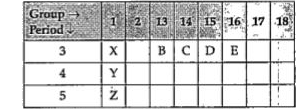According to Newland's classification the properties of the 3rd element will find similarity with those of the ___________element
The correct Answer is:10th
To answer the question regarding Newland's classification, we can follow these steps:
1. Understand Newland's Law of Octaves: Newland proposed that when elements are arranged in order of increasing atomic mass, every eighth element has similar properties. This is known as the Law of Octaves.
2. Identify the Position of the Third Element: In any sequence of elements, the third element is the one we are focusing on.
3. Determine the Eighth Element: According to Newland's classification, to find the element that has similar properties to the third element, we need to count eight places forward from the third element.
4. Count the Elements: Starting from the first element:
- 1st element
- 2nd element
- 3rd element (this is our focus)
- 4th element
- 5th element
- 6th element
- 7th element
- 8th element (this element will have similar properties to the 3rd element)
5. Conclusion: Therefore, according to Newland's classification, the properties of the 3rd element will find similarity with those of the 8th element.
Final Answer:
The properties of the 3rd element will find similarity with those of the 8th element.
---
- 1st element
- 2nd element
- 3rd element (this is our focus)
- 4th element
- 5th element
- 6th element
- 7th element
- 8th element (this element will have similar properties to the 3rd element)
The properties of the 3rd element will find similarity with those of the 8th element.
Topper's Solved these Questions
- PERIODIC CLASSIFICATION OF ELEMENTSBOOK - PEARSON IIT JEE FOUNDATIONCHAPTER - PERIODIC CLASSIFICATION OF ELEMENTSEXERCISE - Level 2
24 Videos
- PERIODIC CLASSIFICATION OF ELEMENTSBOOK - PEARSON IIT JEE FOUNDATIONCHAPTER - PERIODIC CLASSIFICATION OF ELEMENTSEXERCISE - Level 3
10 Videos
- PERIODIC CLASSIFICATION OF ELEMENTSBOOK - PEARSON IIT JEE FOUNDATIONCHAPTER - PERIODIC CLASSIFICATION OF ELEMENTSEXERCISE - Level 3
10 Videos
- Organic ChemistryBOOK - PEARSON IIT JEE FOUNDATIONCHAPTER - Organic ChemistryEXERCISE - Level 3
9 Videos
- WATER, SOLUTION, SOLUBILITY AND HYDROGENBOOK - PEARSON IIT JEE FOUNDATIONCHAPTER - WATER, SOLUTION, SOLUBILITY AND HYDROGENEXERCISE - Level - 2
17 Videos
Similar Questions
Fill in the following blanks with suitable words:
(a) The basis for modern periodic table is…………..
(b) The horizontal rows in a periodic table are called…………….
(c) Group 1 elements are called………………..
(d) Group 17 elements are known as...................
(e) Group 18 elements are called.................
(f) According to Newland's classification of elemetns, the properties of sulphur are similar to those of oxygen because sulphur is the ............. element starting from oxygen.
View SolutionOn the basis of Newlands' classification of elements, the properties of sulphur are similar to those of oxygen because sulphur is the _____ element starting from oxygen.
View Solution
Knowledge Check
According to the Periodic Law of elements, the Variation in properties of elements is related to their ?
Anuclear neutron - proton number radiusBatomic massesCnuclear massesDatomic numbersAccording to the Periodic Law of elements, the Variation in properties of elements is related to their ?
ANuclear massesBAtomic numbersCNuclear neutron-proton number ratioDAtomic massesAccording to periodic law of elements, the variation in properties of elements is related to their:
AAtomic numberBAtomic massCNuclear massDNeutron-proton ratio
State whether the following statements are true or false:
(a) Newlands divided the elements into horizontal row of eight element each.
(b) According to Mendeleev's periodic law, the properties of elements are a periodic function of their atomic numbers.
(c) The elements in a group have consecutive atomic numbers.
View SolutionIn doberiener 's classification the atomic weight and the properties of the first element are almost equal to the average of those of the 2nd and 3rd elements of a triad
View Solution
Identify the elements which have similar chemical properties as the element X.
View SolutionWhat are the similarities in properties of elements in halogen family?
View SolutionAccording to the Mendeleev Periodic law of elements, the variation in properties of elements is related to their
View Solution
